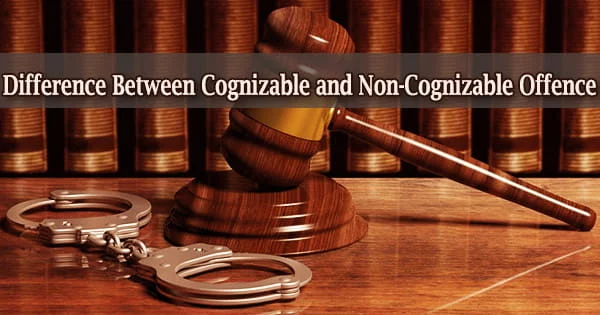In the legal systems of India, Sri Lanka, Bangladesh, and Pakistan, there are two types of crimes: cognizable and non-cognizable. An offense denotes a wrongdoing or a crime. In a nutshell, an offence is any act that is criminal by law and for which a complaint is filed with the relevant authorities, such as the police or a magistrate.
The crime can be categorised as either a cognizable or non-cognizable offense, with the cognizable offense implying that the police can arrest the accused without a warrant. In general, a cognizable offense is one in which a police officer has the ability to make an arrest without a warrant and initiate an investigation with or without the approval of a court.
Non-cognizable offenses, on the other hand, are those in which the police are unable to arrest anyone without a warrant, and inquiry requires the express authorization of the court. When it comes to crimes, it’s important to comprehend the distinctions between cognizable and non-cognizable offenses in order to better understand the law.
Cases that can be recognized are more serious than those that cannot. Serious offenses are usually classified as cognizable and incur a penalty of three years or more. The I.P.C. defines legal meaning and determines whether or not an act is a criminal offense.
The Criminal Procedure Code (CrPC) lays forth the steps for starting a criminal investigation/prosecution. CrPC specifies the mode and location in which an investigation and trial of an offence must take place.
Cognizable Offence –
A cognizable offence is one for which a police officer can make an arrest without a warrant or without the approval of a magistrate under the terms of a first schedule or any other law in effect at the time. There are no criteria in the Code of Criminal Procedure for determining whether an offense is cognizable or not.
The Schedule, on the other hand, relates to all of the offences under the Indian Penal Code and categorizes them as cognizable or non-cognizable. In such cases, once the accused is apprehended, he or she will be brought before the magistrate within the time limit.
In cognizable offenses, the court’s acceptance is implicit because the crime is serious in character. Recognizable offenses are serious in nature. Because of the nature of the offense, the maximum penalty is imposed. Murder, rape, rioting, theft, dowry death, kidnapping, criminal breach of trust, and other grave crimes are examples of cognizable offenses.
Non-Cognizable Offence –
“Non-cognizable offence” actually refer to situations in which a police officer does not have the authority to arrest without a warrant and does not have the right to begin an investigation without prior court approval. Forgery, violence, cheating, defamation, public nuisance, harm, mischief, and other offences are included.
Non-cognizable offences include assault, forgery, cheating, defamation, and public annoyance, among others. Such offenses are minor in nature and cause little harm to society. Before criminal procedures begin, the offended person is expected to file a complaint.
The judicial process for a non-cognizable offence begins with the filing of a criminal complaint with the metropolitan magistrate, who then directs the concerned police station to conduct an investigation, following which a charge sheet is submitted with the court, followed by the trial. Following the trial, the court will make orders for the issuance of an arrest warrant for the accused.
Key differences between Cognizable and Non-Cognizable Offence:
- A cognizable offence is one in which the police take cognizance of a crime on their own initiative and without the requirement for court approval. In non-cognizable, police have no jurisdiction to arrest a person for a crime without first obtaining judicial consent.
- A person can be arrested without a warrant for a cognizable offense. In the case of a non-cognizable offense, however, a warrant is required.
- A court order is not required to begin an investigation into a cognizable offense. In the case of a non-cognizable offense, however, a court order is required before an inquiry can begin.
- Cognizable offences are heinous crimes, whereas non-cognizable offences are not so serious.
- Murder, rape, theft, kidnapping, counterfeiting, and other crimes are examples of cognizable offenses. Non-cognizable offenses, on the other hand, include forgery, cheating, assault, defamation, and so on.
- A person can submit a FIR or make a complaint to the magistrate for a cognizable offense. In contrast, in the instance of a non-cognizable offense, the only recourse is to file a complaint with the magistrate.
The function of the police is critical, and the use of police power should be honest and authentic rather than arbitrary. Cognizable offenses are either bailable or non-bailable, depending on the gravity of the crime, whereas non-cognizable offenses are available.
Non-cognizable offenses are punished with a sentence of less than three years in jail or a fine only, whereas cognizable offenses are punished with a sentence of three years or more in prison. There should be no distinction between cognizable and non-cognizable offenses, and all crimes should be required to be registered.
















